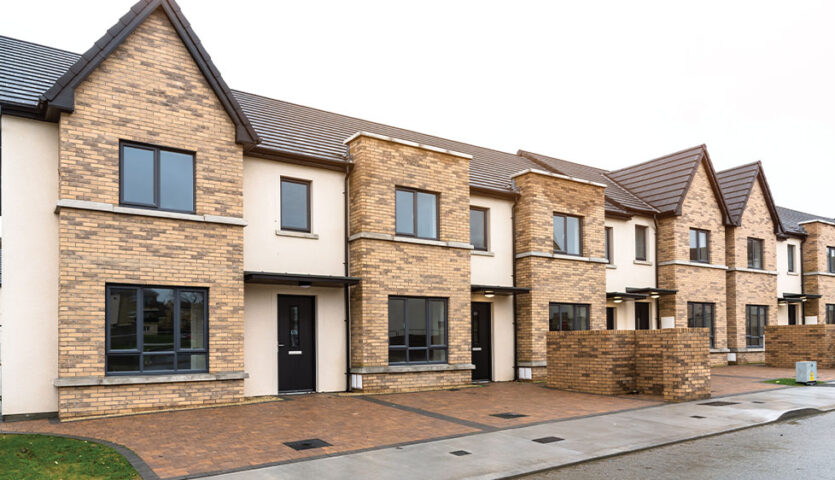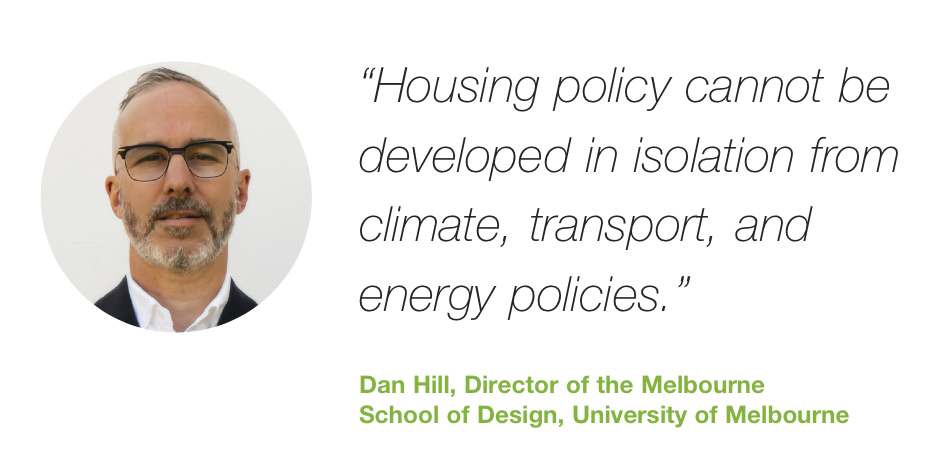
How Europe can provide insights for Irish AHBs
1st July 2025
Fold Housing: Working to meet the housing and care needs of older people
1st July 2025Climate considerations for housing policy

Dan Hill, Director of the Melbourne School of Design at the University of Melbourne, discusses examining climate policy integration with housing policy.
The Irish housing market continues to face significant supply constraints, with annual delivery targets set at approximately 50,000 units to meet projected demand. “The focus on quantitative delivery targets is typical, given the way the largely supply-side approaches to housing policy that tend to dominate,” Hill says. “However, this relatively narrow focus frequently fails to account for broader systemic considerations, particularly regarding immediate challenges of environmental sustainability, housing quality, existing housing stock, or long-term affordability and social justice.”
Data from the Central Statistics Office (CSO) indicates that while housing completions have increased by 18 per cent year-on-year, challenges persist regarding the composition of this supply. “The predominance of three- and four-bedroom detached dwellings, within a focus on new construction, does not align with demographic trends showing increasing numbers of single-person households, nor the importance of retrofitting what we have already built,” Hill observes. “This mismatch between supply and demand characteristics, or housing needs versus industry desires, tends to represent one of many structural inefficiencies in housing delivery systems.”
Construction methodology
On the environmental implications of current construction practices, Hill says: “Business-as-usual construction methods, tending towards brick, concrete, and steel, typically generate significant emissions per square meter of housing space constructed,” he stated. “When multiplied across tens of thousands of housing units annually, the cumulative emissions impact pushes way beyond the ‘planetary boundaries’ implied by the Paris Agreement, which almost all countries, including Ireland, have signed up to.”
Comparative data from the Building in a Climate Emergency research initiative suggests that alternative construction approaches could radically reduce these emissions. “Predominantly working with biomaterials – such as numerous forms of timber, hempcrete, straw panel insulation, stone and for instance, offer comparable structural performance with significantly lower embodied carbon, as would carefully re-purposing existing building materials,” Hill explains. “Several European jurisdictions have successfully implemented such methods at scale, including Sweden, Austria, Denmark, and France.”
Retrofit potential and existing stock utilisation
Hill emphasises the underutilised potential of Ireland’s existing housing stock. “Approximately 65 per cent of Ireland’s residential buildings were constructed before 1990, with many exhibiting poor energy efficiency characteristics,” he notes. “Comprehensive retrofit programmes could simultaneously address housing adequacy and climate objectives, as well as improving health outcomes.”
The Sustainable Energy Authority of Ireland estimates that deep retrofits could reduce energy consumption in these properties by between 60 and 70 per cent.
“The economic case for retrofitting becomes particularly compelling when considering whole-life cost analysis,” Hill adds. “While initial capital costs are higher than conventional refurbishment, the long-term operational savings and emissions reductions justify the investment.”
Land use policy and spatial planning considerations
Discussing the relationship between land use policy and housing outcomes, Hill asserts: “Many of the world’s cities are now actively moving beyond car-dependency, reversing the trends of the second half of the 20th century. Cities such as London, Barcelona, New York, Paris, Singapore, Tokyo, Stockholm, Copenhagen, and Amsterdam are all squeezing the car out of public spaces, like streets, and actively reducing overall car use. Yet current zoning regulations in many Irish local authorities, as with many Australian cities, continue to prioritise low-density, car-dependent development patterns. This approach not only increases per-unit infrastructure costs but also locks in high-emission transportation patterns, along with poor health outcomes, for decades.”
Comparative analysis of European planning systems suggests alternative models. “The ‘compact city’ policy framework common to many other European cities demonstrates how strategic densification around transport nodes could support housing delivery in Ireland too, reducing environmental impacts whilst increasing public health, particularly in the Greater Dublin Area,” Hill states.
Financial mechanisms and policy instruments
Hill believes that existing financial and regulatory mechanisms could support more sustainable housing delivery.
“Current market conditions continue to favour conventional development models due to established valuation practices and financing structures. Policy interventions could help recalibrate these incentives.”
He cites several potential instruments:
- differentiated development levies based on sustainability performance, particularly now including embodied emissions;
- accelerated capital allowances for very low-emissions construction methods;
- mandatory whole-life emissions assessments for major developments; and
- reform of property tax systems to reflect environmental performance and reduce financialisation of the housing sector.
“Such measures have been successfully implemented in various jurisdictions, yet Ireland must find its own way forward here,” Hill says. “That will depend on clear regulatory and policy signals and consistent enforcement, as well as invention and innovation by industry and community.”
Skills development
“Transitioning to more sustainable construction methods requires parallel investment in workforce development,” Hill says. “Current programmes, from higher education to apprenticeships, often lack comprehensive coverage of emerging technologies and methodologies, and crucially about whole lifecycle emissions.”
Governance and policy coordination
Hill emphasises the importance of cross-departmental coordination. “Housing policy cannot be developed in isolation from climate, transport, and energy policies,” he states. “The current siloed approach to policy development frequently results in contradictory outcomes and missed synergies.”
Concluding, he says the mission-oriented approach taken by the Swedish Government’s innovation agency Vinnova “provides a useful case study for building nationwide movements, aligning sectoral policies with overarching sustainability goals, and bringing together public, private, and community sectors with shared ambition”.







